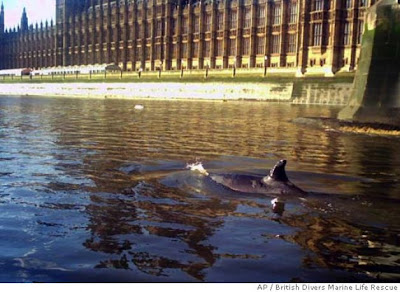June 2013: Sperm whale stranded in the Thames' riverbank in Greenwich, London!!
Strange isn't it?? How could it be possible??
Here is the answer http://www.bbc.co.uk/news/uk-england-london-22983124
University Museum of Zoology, Cambridge (UK)
Cetaceans in the museums
 |
| Skeleton of a finback whale, Balaenoptera physalus. |
 |
| Orcinus orca skeleton |
Natural History Museum of London
Cetaceans are one of the most impressive animals in museums due to their size.
Blue whale, Balaenoptera musculus, life-size model and other cetacean skeletons in the Natural History Museum of London.
A northern bottlenose whale Hyperoodon ampullatus in central London!!!!! and this is true!!!!
The reasons for the whale's presence in the Thames were unclear. A number of possible causes were raised prior to the post-mortem:
- Illness. Some previous whale strandings are believed to have been caused by physical ill-health, resulting from factors such as parasite infections or pollution, which can disorientate whales and cause them to strand themselves in shallow water.
- Noise pollution. There have been a number of incidents in which military sonar systems have caused hearing damage to marine mammals. It was suggested that Royal Navy sonar testing may have been a factor; however, the post-mortem revealed no damage to the whale's auditory functions.
- A navigational error. According to the scientists who conducted the post-mortem, the most likely explanation for the incident was simply that the whale was seeking to return to its normal feeding grounds in the North Atlantic and took a wrong turn, mistakenly swimming west up the Thames rather than taking the longer route around the coast.
Cetaceans in art
1973 Girl with a dolphin statue by David Wynne, near historic tourist attraction Tower Bridge over river Thames in London.
Meetings, conferences and environmental education activities related to the conservation of cetaceans and their environment are performed all over the world
I attended the Whale Fest in Brighton in October 2012 where I met people with different background (from researchers to whale watching companies and others) with a common interest in cetaceans and environmental conservation.
http://www.whale-fest.com/


.JPG)
.JPG)
.JPG)
.JPG)








